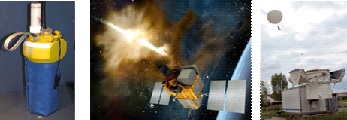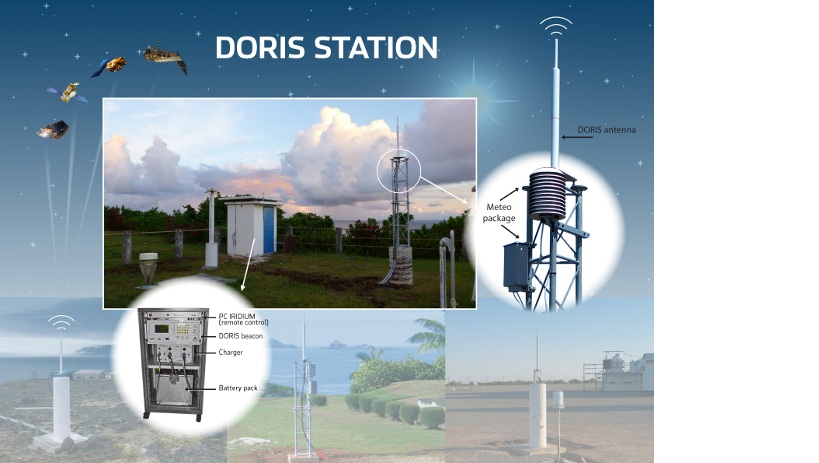The DORIS signal is emitted by the DORIS ground stations. The DORIS signal is free, there is no restriction on using it.
The network deployed for DORIS is global, dense and homogeneous, and thus unique among the different techniques that contribute to the International Terrestrial Reference Frame (ITRF). The very good stability of this network through time (very few changes of antennas or sites), and its uniform distribution (North/South) are essential for the quality of the DORIS Reference Frame.
Improving the equipment clearly contributes to better accuracy, as it can be seen, for instance, on the time series of several upgraded stations.
Ground stations
Every station is fitted with:
- in a local:
- a DORIS beacon i.e. a dual-frequency 400 MHz and 2 GHz transmitter including an Ultra Stable Oscillator (USO), a power pack with a charger, a battery to provide power supply autonomy, a remote control system (IRIDIUM);
- outside:
- an omni-directional dual-frequency antenna;
- sometimes a meteorogical package providing temperature, pressure and humidity measurements, used for tropospheric correction.
images courtesy of IGN
The DORIS Network is composed of about 60 ground stations.
Among these, most are defined as Orbitography Beacons (BO) which will be used as geographic references by orbit determination software. Others are scientific IDS (International DORIS Service) stations.
Some of these Orbitography Beacons also play the role of Time Beacons (BT). The Time-Beacon clocks are linked to atomic clocks. Clocks delays are precisely determined and monitored with respect to the International Atomic Time (TAI).
Some BTs are also Master Beacons (BM), 4 in January 2013) : they also emit broadcast uploads.
In January 2013, 38 stations are co-located with stations of other high precision space geodetic techniques (Very Long Baseline Interferometry (VLBI), Satellite Laser Ranging (SLR), Global Navigation Satellite System (GNSS). These co-locations allow system intercalibrations. Long-term life and stability are the key qualities of the DORIS network, and several time series are extremely long (many measurements started in 1990 with the first DORIS receiver flight on-board SPOT2).
DORIS network management
Since almost 25 years, the DORIS network has been designed, deployed and managed through a French partnership between the Centre National d’Etudes Spatiales (CNES) and the Institut National de l'Information Géographique et Forestière (IGN). IGN has been put in charge of its deployment and of all relevant geodetic activities (station coordinates determination, local tie surveys…) while CNES operates and maintains the stations. The DORIS network is in constant evolution, some stations are renovated, some are moved and some news are planned as well. In short, we can say that these actions are carried out by the “DORIS Network Team” where IGN and CNES use their respectives expertise to provide a reliable and robust ground network.
The DORIS Network Team also handle administrative procedures (e.g. drawing up convention between CNES-IGN and Host Agencies, getting the permits to emit DORIS Radio Frequency (RF) signals, etc) and manage logistic support (expedition time, standard exchange duration, possible on-site redundancy, spare parts capacity and procurement time, etc).
DORIS products quality is strongly linked to the quality of the network. The network status is weekly checked during specific DORIS meetings, and more frequently when a DORIS receiver launch is coming up. An “Integrity Team” regularly reports on the status and precise availability of the beacons.
Moreover, as a DORIS ground station is not passive with respect to the overall DORIS system and may have impacts on the main objectives of this network (i.e. altimetry, geodesy, …), the “Integrity Team” routinely pays attention to the DORIS signal integrity and to the onboard receivers.
In order to ensure optimum availability, CNES and IGN decide and organize actions on the stations taking account of the Integrity Team results. Sometimes these actions can be performed directly by the Host Agency.
The network status depends on:
- the number of Orbitography Beacons in activity,
- the number of Time Beacons,
- the number of Master Beacons.
It also depends on the logistics, e.g. the supply deliver time, standard replacement time, the number of spare available on site, the stock size, the time needed to supply new equipment.
Installation of a new DORIS station
Requirements
The installation of a new DORIS station must be compliant with differents requirements, including:
- geographical coverage and network robustness,
- geodetic stability,
- transmission authorization,
- interferences,
- accessibility,
- antenna environment,
- electrical power supply,
- materials,
- co-location with tide gauge or other space geodetic instruments
- ….
All these requirements are described in the applicable document:
System Requirements For Management Of The DORIS Station Network
A description of the standard configurations compliant with the DORIS system requirements applicable to the management of the DORIS station network is given in the document:
DORIS site standard configurations
The RF characteristics are also described in the document:
DORIS beacon RF characteristics
Choosing a site to install a new station
Regarding the installation of a new DORIS station, we must consider two types:
1/ Permanent stations belong to the permanent DORIS network. They are used for altimetric missions currently in orbit, for the Precise Orbit Determination (POD) of these satellites.
2/ Scientific stations, also called IDS stations. These stations are used for scientific purposes (dependent on the IDS Governing Board's approval). Such stations have a lower level of priority than the permament stations, but they must comply with the same installation requirements and are maintained with the permanent network by the same CNES-IGN teams.
For the reasons mentioned earlier, related to the global maintenance and the integrity check of the DORIS system, all the DORIS stations (permanent and IDS) belong to the CNES.
The intallation criteria depend on the type of station:
- For a new permanent station, the main criterion is the improvement of signal coverage in a given region.
- For a new IDS station, the main criterion is the scientific interest (geodesy, tectonic plates coverage, co-location, inter-calibration with other techniques, …). To be selected as an IDS station, the site candidate must meet additional requirements and constraints listed below:
DORIS signal:
The beacon will emit with a shifted frequency in order to avoid interferences with an other DORIS station that belongs to the permanent network. The proposal is accepted if the results of internal jamming analysis performed by CNES show that there is a frequency shift which meets the jamming requirement.
IDS stations are not programmed on board, reception depends on availability of a free channel on board.
Material:
The CNES-IGN Doris project has a pre-emptive right on IDS material if the permanent network requires it.
Host Agency:
Regarding the installation of a new IDS station, the activity shall be considered in partnership with the host agency which should support CNES for the station installation and operations (hosting, power supply, air conditioning,…).
The DORIS project is not responsible for the IDS station, therefore the transmition authorization must be obtained (before DORIS material delivery) and renewed by the host agency.
Scientific reports are required (at least one at the end of the campaign).
Policy concerning DORIS station owned by another agency
Today, there is no policy concerning a ground station funded and owned by another agency.
Indeed, the cost of an operational DORIS station is difficult to estimate. In addition to the hardware equipment itself (beacon + antenna), installation, frequency clearance, maintenance and monitoring have to be funded over several years. Currently, all these costs are handled by CNES.
More over, unlike a station GNSS, a DORIS station is transmiting (not passive), thus its installation must be managed and controlled by the DORIS system administrators.
That is why, we only consider IDS stations owned by CNES in partnership with the host agency.
DORIS compatibility with other systems
While it is highly desirable to co-locate the various space-geodetic techniques at as many locations as possible for comparison and combination purposes, the co-locations should not lead to substantial degradations of one or more of the techniques. To do this, the spacing between the techniques as well as mitigation measures need to be considered carefully.
The compatibility of DORIS with differents systems has been examined. This section includes a brief description and the corresponding documentation.
We have considered Radio Frequency Interferences between DORIS and space geodetic (GNSS, SLR, VLBI) or other (SVOM, ARGO, Radio-sounding) systems.
The status of mid 2012 is described in the presentation:
Overview of DORIS Frequency Permits, RFI Issues Worldwide (P. Ferrage (CNES), IDS Workshop 2012)
Conclusions of compatibility exams (as of mid-2012)
Interference with other Space Geodetic techniques:

- GNSS: no interference with GNSS receivers. Interference with Galileo TM station will have to be checked when such co-location occurs.
- SLR: no interference
- VLBI:
- current VLBI: no interference
- See About the compatibility of DORIS and VLBI observations (Gennady Il'in et al, IVS 2010 general Meeting)
- Thanks to good cooperationbetween IVS (International VLBI Service) and IDS, tests were performed in Yarragadee and the compatibility VLBI/DORIS was confirmed (see IVS letter regarding compatibility of DORIS and geodetic VLBI (6 August 2012))
- VLBI2010: risk of interference, must be managed. (see presentation Colocation considerations and Radio Frequency Interference (RFI) Mitigation Techniques (L. Hilliard (NASA/GSFC), IDS Workshop 2012)
- current VLBI: no interference
Interference with other systems:

- ARGO: No interference
- SVOM: No interference
- Radio-sounding system: interference may occur but can be avoided with specific recommendations easy to implement.




